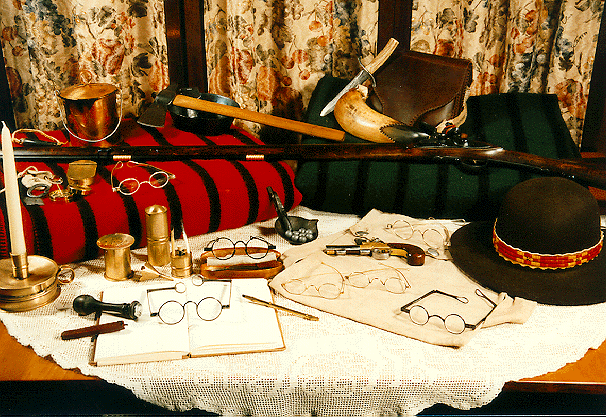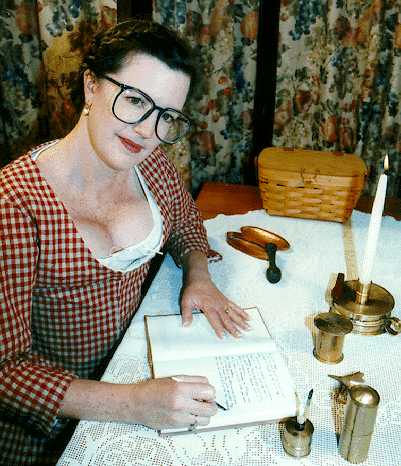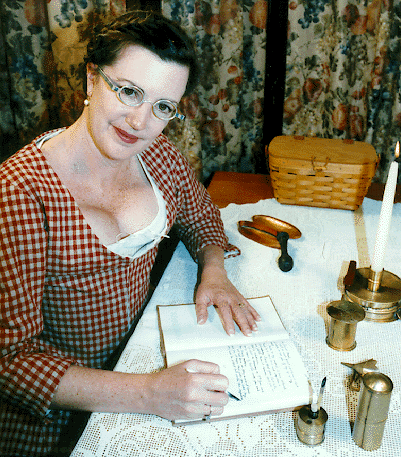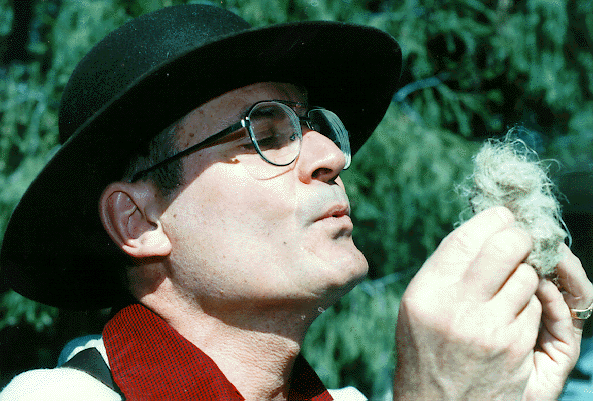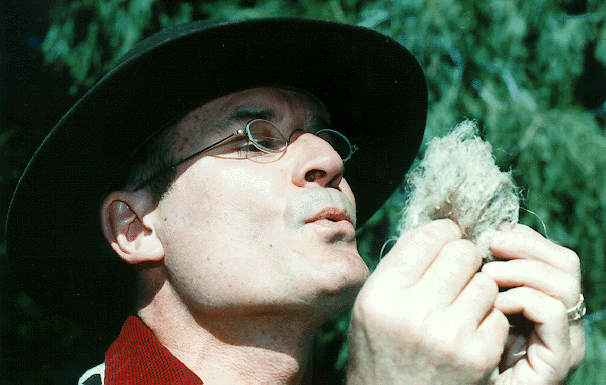|
Muzzle Blasts Online |
|
...for the muzzleloading enthusiast |
|
The muzzleblasts.com domain, subdomains, content, etc., are neither affiliated with the NMLRA nor its paper magazine Muzzle Blasts |
|
Muzzle Blasts Online |
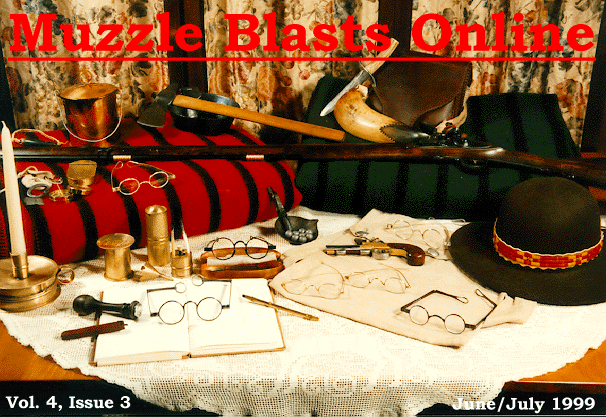
|
|
|
|
|
|
Seeing Eye to Eye on Authentic Spectacles for Reenacting
My wife Cynthia and I stumbled upon our first Rendezvous while out backpacking in the California mountains a few years ago. We were enchanted by our first view of the Manzanita Hunting Club's event, and that enchantment remains strong to this day. Like many pilgrims, we wandered about completely in awe as we gazed upon all the tipis, wall tents, and wedges. From the blacksmith stoking his forge to the trappers in their buckskins, we thought it all quite grand! From that point on, we knew we had to learn about and get involved in this lifestyle. Though we didn't know brain-tan from chrome-tan, we thought it all looked great, with one glaring exception. We couldn't understand why folks would go to such extremes to live the life of the fur trappers and traders and then wear their own modern eyeglasses! As we looked at all that surrounded us, even with no experience to tell us why, those modern frames stuck out like a Coleman stove or electric light in the tipi would have! What was the reason that many reenactors would spend tons of time and money on their authentic period outfits and then throw mud on all they'd done by wearing modern eyeglasses? After being in the sport for a few years now, we are still amazed that so many participants ignore this very important aspect of our hobby. Please notice that I won't tell you what tent to use, debate the use of flint over percussion, or brain-tan over chrome-tan, wool or linen. These are choices we all have to make. But you are doing yourself a big disservice if you wear your modern eyeglasses with whatever else you choose to use!
A brief history of eyeglasses: The first use of spectacles was in Italy, and has been dated back to about 1287 AD. These first eyeglasses were no more than a single lens of glass held in the hand by a handle. We will limit our discussion to the 18th and 19th centuries, as these are the periods most of us are interested in reenacting. It was in the 18th century that the first practical spectacles were either hand held, tied on with cord looped over the ears, attached to weighted cords run behind the ears, or even held on by metal forehead frames that must have truly been uncomfortable! Frames were made of leather, horn, gold, silver, brass, and steel. Sometime between 1727 and 1730 a London optician named Edward Scarlett invented and promoted the use of spectacles held in place with rigid side pieces. These early examples were mostly silver, steel, or brass with round lenses and hinged side pieces with large velvet-covered rings at the ends, which pressed against the head to hold the spectacles on. As time progressed into the 19th century, oval, square, and octagonal lens shapes became popular. Lenses in different colors were thought to be of medical benefit. Green lenses were believed to help stomach problems; blue lenses for blood related diseases; and yellow lenses for poor vision. Large frames became smaller and more compact, and ear pieces lost the temple rings and went from flattened wire ends to bent spring wire at the very end of the 19th century. The modern nose piece with standoffs was also not used until the end of the 19th century. Nose pieces in the 18th and 19th centuries were "C-" or "W-" shaped "saddles" for the nose.
By the way, when Ben Franklin invented bifocals, he used two separate pieces of glass in the same frame. The lower half was for reading and the upper half for distance vision. Today, if you want to approximate the same look, ask your optician for an "executive" bifocal. The line goes all the way across the lens and gives the appearance of the originals.

|
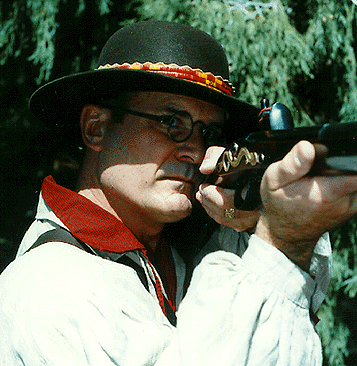
|
|
Mark takes aim with his Caywood smoothbore. Too bad his modern eyeglasses will cause him to miss the authentic look! |
Now Mark's aim will be true using Dr. Ron McDaniel's Ben Franklin bifocals. |
So, my fellow reenactors, now what are your excuses for not looking your best? Now you know where to locate whatever type and style of frames you need. Though the original period frames are a bit small for our modern faces and can be slightly uncomfortable, they can be made usable by adding velvet covers, or brain-tan buckskin thongs to cushion and hold them on. All the reproduction frames I have seen are just fine as they are, though you can add ribbon, velvet, or thong to make them period correct. Those of us who need bifocals can now have them installed authentically in our period frames. And for those who fear that they will have trouble using them with their firearms, I have absolutely no problem shooting rifles, pistols, smoothbores, or shotguns with any of the three pairs of period spectacles that I own! Price can no longer be a stumbling block to acquiring a pair of authentic frames. As you have seen, there are frames that fit even the tightest budget, though you will have to spend some shoe leather to find the absolute cheap buys.
Finally, let me put to rest the argument that "Nobody will notice." Look at the accompanying photos and tell my you think that period spectacles don't make a big difference. Let me guarantee you one other thing, my friends: once you are behind those period lenses, your entire outfit and the rendezvous or event you're attending will look 100% better to the one who matters most...YOU! I've slapped you in the face with the glove. Go ahead. Try to prove me wrong! Once you take this overlooked but very vital step, you will wonder why it took you so long!. Here's looking at you, kids!
For more information about period spectacles or to purchase from those sources I've mentioned:
Fashions in Eyeglasses, by Richard Corson, Published 1967 by Peter Owen, London. (out of print, but I found a copy through Amazon.com on the Internet)
Early American Specs, by Dr. L.D. Bronson, Published 1974 by Occidental (out of print; I borrowed a copy from a friend)
James Townsend and Son, Inc., 133 North First Street, P.O. Box 415, Pierceton, IN 46562 (order number: 1-800-338-1665) (18th and 19th century period frames, plus a tin eyeglass case)
Eye Wear Unlimited, Stanley A. Steiner, 816 N. Baldwin, Marion, IN 46952 (765) 664-6848. (18th century frames and lots of 19th-century styles, some with more modern and comfortable ear pieces, also some period eyeglass cases)
Rendezview Eyewear, Dr. Ron McDaniel, P.O. Box 200, Shelbyville, IN 46176 (317) 398-0305. (hand made 18th- century silver spectacles...worth the price and the wait!)
Ed Welch's Antiques, RR 3 Box 1290, Winslow, ME 04901 (207) 872-5849. Email: metiques@mint.net (a fine collection of original period eyeglasses from the 18th and 19th centuries, some with colored lenses, to cure what ails ya, and many with cases).
